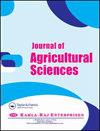Selection of Differentially Expressed Genes Using the Transcriptome Analysis of Ripening Grape Berries in Response to High Temperature
IF 0.7
Q3 AGRICULTURE, MULTIDISCIPLINARY
引用次数: 3
Abstract
Purpose: The transcriptome of ‘Campbell Early’ grape berries exposed to high temperature was analyzed to select useful genes by evaluating their differential expression through sequencing short reads on Solexa platform. Research Method: We assembled 118 million high-quality trimmed reads using Velvet followed by Oases. Findings: Functional categorization of expressed transcripts revealed the conservation of genes involved in various biological processes like responses to chemical (12.7%), responses to abiotic stimulus (11.8%), biosynthesis processes (11.8%), and cellular metabolic processes (10.4%) in grape berries exposed to high temperature. The major up-regulated genes included isocitratelyase, cysteine proteinases superfamily protein, cupin family protein, and glycosyl hydrolase genes, and the major down-regulated genes included flavanone 3-hydroxylase, phenylalanine ammonia lyase, chlorophyll A-B binding family protein, and polygalacturonase inhibiting protein genes in grape berries exposed to high temperature. Among genes related to grape coloration, expressions of chalcone and stilbene synthase, flavanone 3-hydroxylase, leucoanthocyanidin dioxygenase, phenylalanine ammonia lyasegenes were more strongly inhibited in berries kept at 35°C than 25°C. Originality/Value: Transcript sets of grape berries generated in this study will provide a resource for gene discovery and development of functional molecular markers to be used in elucidating the mechanism of tolerance to high temperature.利用成熟葡萄果实对高温响应的转录组分析选择差异表达基因
目的:在Solexa平台上对Campbell Early葡萄果实在高温下的转录组进行分析,通过短读测序评估其差异表达,筛选有用基因。研究方法:我们使用Velvet和oasis收集了1.18亿个高质量的修剪reads。结果:表达转录物的功能分类揭示了高温下葡萄果实中涉及多种生物过程的基因的保存,如化学反应(12.7%)、非生物刺激反应(11.8%)、生物合成过程(11.8%)和细胞代谢过程(10.4%)。高温下葡萄果实中上调的基因主要有异柠檬酸酶、半胱氨酸蛋白酶超家族蛋白、库平家族蛋白和糖基水解酶基因,下调的基因主要有黄酮3-羟化酶、苯丙氨酸解氨酶、叶绿素A-B结合家族蛋白和多半乳糖醛酸酶抑制蛋白基因。在与葡萄变色相关的基因中,查尔酮和二苯乙烯合成酶、黄酮3-羟化酶、浅色花青素双加氧酶、苯丙氨酸氨溶酶的表达在35℃的贮藏条件下比在25℃的贮藏条件下受到更强烈的抑制。独创性/价值:本研究生成的葡萄果实转录集将为基因发现和功能分子标记的开发提供资源,用于阐明葡萄耐高温机制。
本文章由计算机程序翻译,如有差异,请以英文原文为准。
求助全文
约1分钟内获得全文
求助全文
来源期刊

Journal of Agricultural Sciences
AGRICULTURE, MULTIDISCIPLINARY-
CiteScore
1.80
自引率
0.00%
发文量
0
 求助内容:
求助内容: 应助结果提醒方式:
应助结果提醒方式:


